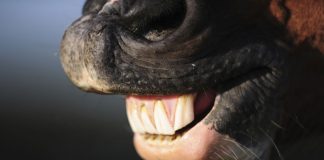Colic. The mere word sends shivers down horse owners’ spines. Whether it’s a relatively simple case of gas or a potentially deadly
impaction or intestinal displacement, whenever your horse shows signs of colic, call the vet immediately.
- not eating or drinking
- lying down and/or rolling more frequently than normal
- pawing the ground
- kicking the belly or looking at the abdomen
- standing as if to urinate, but not actually urinating
- curling the upper lip
- yawning
- sweating heavily
- standing quietly and/or rigidly
- reluctance to move
- staggering gait or nearly falling
Before you call the vet, make a list of any symptoms your horse is displaying. Also take your horse’s temperature and heart rate, and
check his mucous membrane color. Let your vet know your findings. If your vet gives you instructions to follow, proceed with them.
Beyond this, what can you do? While you’re waiting for the vet to arrive, apply pressure to the following acupressure points. “Restoring
the energy flow in the body can help mitigate some of your horse’s discomfort,” explains Nancy Zidonis, one of the three authors of
Equine Acupressure: A Working Manual (Equine Acupressure Inc; 3rd edition; June 1999).
“We’ve seen excellent results when acupressure is performed on horses with colic, even if the person giving the treatment is not an
experienced acupressure practitioner,” adds Amy Snow, author.
To perform this acupressure point work, use the ball of your thumb or place your middle finger on top of your index finger. Apply about
one to three pounds of pressure to each point. When you feel resistance in the point, let up slightly with the pressure and then apply
pressure again. Exhale as you press into it, and inhale as you slowly release.
The following diagrams, from “Equine Acupressure: A Working Manual,” give you a general idea of where the acupoints are located.
How can you be sure?
Click Here to View the Colic-Impaction Diagram
Click Here to View the Colic-Flatulent or Gas Diagram
Click Here to View the Colic-Preventive Diagram
“Acupoints are found in the valleys of the body—in the depressions next to or between muscles, bones, tendons and around joints,”
explains Marie Soderberg, author. “They’re not on the top of bones or in the belly of a muscle. And, often, acupoints look and feel
different than the surrounding area of the body. They feel harder or softer, warmer or cooler, and are more sensitive to touch.”
Kara Stewart is a freelance writer based in Colorado.






good article
Thanks! I downloaded and saved the charts.
I printed chart thank you
My 23 year old sometimes has gas colic
Three years ago my horse colicked and passed away. How I wish I would have had this information then!
He was 30 however but in excellant health and I believe that his problem was impactation. The vet did tell me to walk him all night and we did and I did let him rest at times. I realize there are times that there is nothing you can do but to have all this information now is wonderful and very helpful. Thank you for doing this!
Scary.
wow this is really interesting. Thanks for the info guys!!!